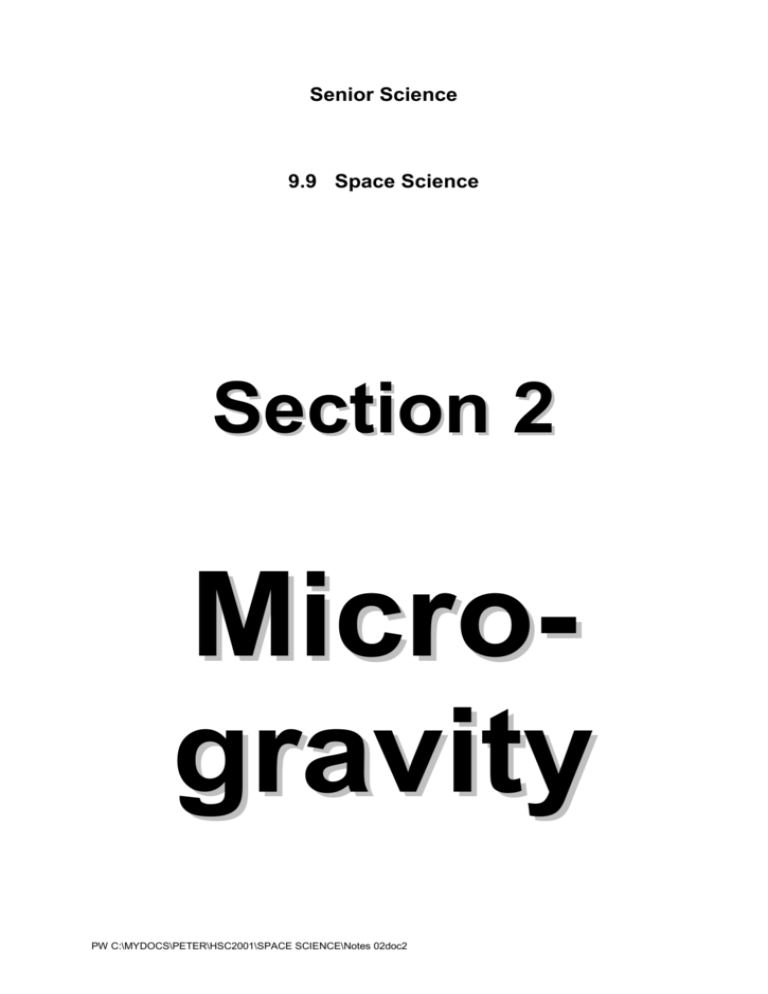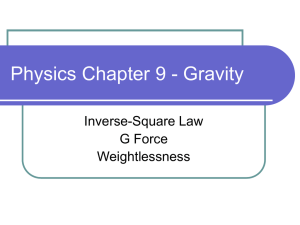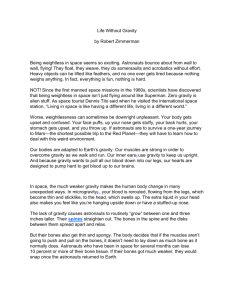Notes Questions
advertisement

Senior Science 9.9 Space Science Section 2 Microgravity PW C:\MYDOCS\PETER\HSC2001\SPACE SCIENCE\Notes 02doc2 Section 2 :: Micro-gravity The strength of gravity varies at different points in space 9.9.2.a Identify the relationship between mass and gravitational pull and relate this to the revolution of the Moon around Earth and the revolution of the planets around the Sun 9.9.2.b Identify situations on Earth where one could experience ‘weightlessness’ 9.9.2.c Discuss reasons for the apparent weightlessness of an object in orbit 9.9.2.i Gather, process and present information from secondary sources to identify and discuss the reasons why animals were sent into space before humans © P Wilkinson 2002-04 2 9.9.2.a Identify the relationship between mass and gravitational pull and relate this to the revolution of the Moon around Earth and the revolution of the planets around the Sun MASS AND GRAVITATIONAL PULL According to Isaac Newton: An object will move in a straight line unless acted on by a NET force. Therefore, an object moving in a circle must have a NET force acting on it Quick Activity Tie a string onto a small solid object. Spin the around in a circle. Question What causes the object to move in a circle? Question Does the string exert a force on the small solid object? Answer The small object moves in a circle because the string exerts a force. The force is called a centripetal force and it acts along the string towards the centre of the circle. An object moves in a circle because of a balance between two quantities Inertia - which causes the object to keep moving in a straight line. Centripetal force – which pulls the object towards the centre of the curved orbit. If the object is moving too slowly the centripetal force will pull the object into the centre of the circle. If the object is going too quickly, its inertia will cause the object to move away from the centre of the circle. The moon moves in a curved path around the earth. The planets move in a curved path around the sun. Since neither the moon nor the planets move in a straight line, there must be a NET force acting. Such a force is gravity. Gravity acts on objects with mass. © P Wilkinson 2002-04 3 NEWTON’S LAW OF GRAVITATION Newton’s theory of gravitation states that: The force of gravity between two objects is proportional to the size of their masses. The force of gravity between two objects is inversely proportional to the square of the distance between the masses. That is, the bigger the mass involved the bigger the force between the two objects. The bigger the distance between the masses, the smaller the force between the objects. Mathematically, this has been expressed as F = G x m1 m2 r2 where G =universal gravitational constant m1 m2 = masses of the two objects r2 = distance between the two objects. The gravitational pull of the earth causes the moon to revolve around the earth. The gravitational pull of the sun causes the planets to revolve around the sun. Notes Questions 1. For a moving object, what is the effect of inertia? 2. What does a centripetal force do? 3. What force acts on the moon to keep it in orbit? 4. What is Newton’s theory of gravitation? 5. What causes the planets to move around the sun? © P Wilkinson 2002-04 4 9.9.2.c Discuss reasons for the apparent weightlessness of an object in orbit MICRO-GRAVITY & WEIGHTLESSNESS Many people would say that an astronaut orbiting the Earth at a height of 120 kilometres is “weightless”. This is because the astronaut can “float” around inside the spacecraft. In actual fact the astronaut is not “weightless”. The force of gravity being exerted on the astronaut gives the astronaut weight. Weight is a force. Weight is the force exerted by gravity on an object. Weight = mass x gravity For an object to be weightless it must be placed in a region where gravity is zero. Such a region does not exist near the earth. The strength of the gravitational force, due to the earth, on an object gradually decreases as it moves away from the Earth. If you drop a stationary object at: sea level it will accelerate towards the earth’s centre at 9.8 ms-1 . a height of 120 km it will accelerate towards the earth’s centre at 9.6 ms-1 . This means that at: sea level a 98 kilograms person weighs 98 kilograms. a height of 120 kilometres 98-kilogram person weighs 96 kilograms. This person is not weightless. This fact is not registered on a set of scales. Question Is there any place in space where the earth’s gravity is almost zero and an object would be weightless? Answer At a distance of 6.37 million kilometres from Earth (almost 17 times farther away than the moon) the earth’s gravity is almost zero. In fact it is reduced to one-millionth of that at sea level. At this point, an object is almost “weightless” (with reference to the earth’s gravity). A better term for this situation is micro-gravity [ie. gravitational pull is reduced to onemillionth of that of the earth’s surface]. Notes Questions 6. What is weight? 7. Where is an object “weightless”? 8. What is the acceleration due to gravity at sea level? 9. What is the difference in the acceleration due to gravity at sea level compared to a height of 120 kilometres? 10. Where is gravity almost zero? 11. Think Suggest why the Earth’s gravity must be quite strong near the moon. 12. Think Suggest why the Earth’s gravity must be quite strong near a geostationary satellite. © P Wilkinson 2002-04 5 Acceleration, micro-gravity and weight Micro-gravity (ie a weightless environment) can be created in another way. According to Albert Einstein acceleration can produce the same effect as gravity. This is the Principle of Equivalence. To understand this principle, suppose you are in a rocket ship at rest in deep space – that is, with almost zero gravity and no acceleration. If you let go a ball, it will float and it does not fall. If the rocket then accelerates “upward”, the ball will appear to fall “downward” to the floor exactly as if gravity had acted upon it. Thus, acceleration produces the same effect as gravity. A useful term to describe the situation is micro-gravity. Micro-gravity is an environment: where a mass is weightless because there is almost no gravity or where gravity seems not to be acting. In a similar way, in an elevator falling freely on the earth, an object released by a person does not fall away from the person. Gravity appears to not be acting – this is a micro-gravity environment on Earth. Diagram The relationship between weight and acceleration. 1 2 3 4 1 The person in the stationary elevator experiences normal weight. 2 In the elevator to the right, weight increases slightly because of the upward acceleration. 3 Weight decreases slightly in the next car because of the downward acceleration. 4 The person has no weight in the last car on the right because of free fall – the person is experiencing micro-gravity. © P Wilkinson 2002-04 6 Falling around the Earth A micro-gravity environment can be created through the act of free fall. Consider the following situation. 1. Consider a ball at the edge of a table. Let it drop and it falls straight to the ground. 2. Now give the ball a push. The ball now follows a curved path as it falls to the ground. 3. Give the ball a bigger push. Again, it follows a curved path but travels further as it falls to the ground. Now, imagine as Newton did, a giant cannon is used to fire the ball. 4. Put the ball into a cannon so that it can get a bigger push than before. Again, it follows a curved path but travels further as it falls to the ground. 5. If you put a large enough charge into the cannon, the ball could go completely around the Earth. The ball is now going fast enough so that gravity can pull it in a circle but not back to the earth. The ball is falling around the earth. This is why an astronaut experiences micro-gravity when in space. An astronaut in the space shuttle orbits the Earth at a height of about 250 kilometres. It needs to be remembered that the astronaut still has weight. If the astronaut stopped moving, the earth’s gravity would cause the astronaut to drop towards the earth’s centre. Gravity (the weight force) is still acting on the astronaut and keeping him/her in orbit. The experience of micro-gravity is due to free fall - the astronaut and everything in the spacecraft falls (or accelerates) around the Earth. Everything is falling together and therefore appears to float. If the astronaut stood on a set of scales, the scales would register zero weight (therefore ‘weightless’ – NB not a good term). © P Wilkinson 2002-04 7 Notes Questions 13. Outline an example of the ‘principle of equivalence’ 14. Where can a micro-gravity environment exist? 15. In the diagram (on page 6), when does weight increase? 16. In the diagram (on page 6), when is the person’s weight zero? 17. How can an object be caused to ‘fall around the earth’? 18. If the space shuttle stopped moving (speed = 0) what would happen to it? 19. Why does an astronaut experience “weightlessness” or micro-gravity? 20. Why is the term ‘weightless’ used? HSC Style Questions Discuss reasons for the apparent weightlessness of an object in orbit [5 marks] This question is unstructured and requires an extended answer In order to answer such a question, you must provide some structure. STEP 1 Identify (& highlight) the important words in the question STEP 2 Recall definitions of these important words (if necessary) Discuss – identify issues and provide points for and against Weightlessness – gravity appears not to be acting Orbit – revolving around planet, sun in space STEP 3 Develop your plan that reflects the depth required (Verb & marks) Outline examples or situations where the term weightless is used. Explain the relationship between falling and weightlessness Explain why an astronaut experiences weightlessness when in orbit H2, H4 9.9.2.c HSC style question Marks Marking Criteria Define weight Outline situations where objects are ‘apparently’ weightless Explain how objects in orbit can have weight but are ‘apparently’ weightless 5 Marks 4-5 2-3 1 © P Wilkinson 2002-04 8 Activity 2 Zero gravity or freefall It can be demonstrated that objects that are in free fall seem weightless. Introduction: Aim: Put a hole in a Styrofoam cup. Fill the cup with water. Is it possible to keep the water in the cup without blocking the hole in any way? It is possible only when the water is "weightless" – or better still it is possible in a micro-gravity environment To simulate "weightlessness" demonstration. by performing a freefall Method: 1. 2. 3. 4. Punch a small hole in the side of a Styrofoam cup near its bottom. Hold your thumb over the hole as you fill the cup with water, remove your thumb and observe what happens. Reseal the hole with your thumb and refill the cup. Go outside and drop the filled cup from a height. Results: Describe your observations. Discussion: © P Wilkinson 2002-04 The Zero-Gravity that the astronauts experience is really not zeroG at all. Zero-G means that the gravitational pull in space is zero. This is not true. Astronauts "float" in space because they are in free fall. Their orbit around the Earth produces this free fall. Astronauts and their spacecraft are falling together. The condition is sometimes described as "weightlessness" because a bathroom scale would record zero weight for an astronaut standing on it: the scale would be falling too. 9 9.9.2.i Gather, process and present information from secondary sources to identify and discuss the reasons why animals have been sent into space before humans ANIMALS IN SPACE Introduction Military test pilots were the first people to be trained as astronauts. They had good control and fast reflexes. They were in excellent physical condition. One concern about space flight was the effect of “weightlessness” on the operation of the human body. Would internal organs continue to work? Would the astronauts maintain their reflexes in space? To observe the effects of micro-gravity the astronauts were flown in very high steep arcs. These flights allowed about twenty seconds of micro-gravity. In this time they ate, moved and drank – and showed that micro-gravity was safe in small amounts. The scientists were also concerned about the safety of the space capsule. Would the capsule remain airtight? Where there any problems about space flight that scientists did not consider? The first animal in space was a dog, named Laika. Laika orbited the Earth in a Soviet spacecraft, Sputnik 2. Scientists monitored her physical reactions while in space. Sputnik 2 did not return to Earth, and on the eighth day Laika was put to sleep. The Americans sent monkeys into space before their astronauts. Notes Questions 21. Name two reasons why animals were sent into space before humans 22. Name two physical reactions of Laika that would have been monitored by scientists Research and HSC Style Question 1. Gather information about the reasons why animals were sent into space before humans. 2. Copy and complete the table below to summarise a discussion about the reasons why animals have been sent into space before humans Issue 1 Points for Points against Issue 2 Points for Points against © P Wilkinson 2002-04 10 9.9.2.b Identify situations on Earth where one could experience ‘weightlessness’ EXPERIENCING “WEIGHTLESSNESS” ON EARTH In a practical sense, micro-gravity can be achieved with a number of technologies, each depending upon the act of free fall. Drop towers and drop tubes are examples. The large version of these facilities is essentially a hole in the ground. Drop towers accommodate large experiment packages, generally using a shield to contain the package and isolate the experiment from aerodynamic drag during free fall in the open environment. Suborbital conditions of free fall are limited to less than 10 seconds in drop towers, less than 25 seconds during aircraft manoeuvres, and less than 15 minutes during rocket flights. Suborbital refers to very high steep arcs flown by aeroplanes. These flights allow about twenty five seconds of “weightlessness”. Once in space the duration of “weightlessness” or better still micro-gravity has been extended to days and weeks. With Space Stations the duration has been extended to months and years. Notes Questions 23. What is happening to an object that experiences ‘weightlessness’ on Earth? 24. Think What is a drop tower? 25. How long does weightlessness last for in a drop tower? 26. Name four situations on Earth where one could experience ‘weightlessness’ 27. Research © P Wilkinson 2002-04 Name a movie where the actors were ‘weightless’? 11







